Learn how to make homemade Kombu Dashi, a vegan-friendly Japanese soup stock, to enhance your Japanese dishes with umami flavor. It’s the easiest dashi that you can make!
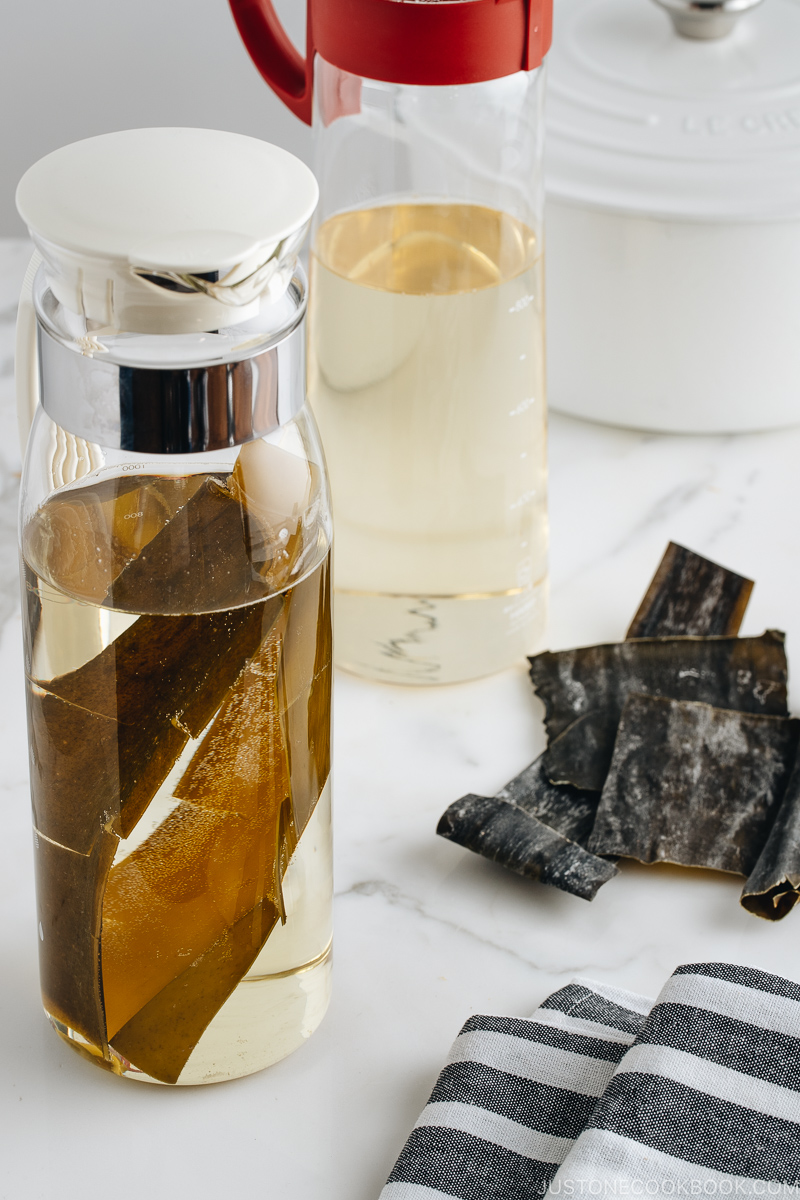
Dashi is Japanese soup stock that is a fundamental ingredient in many Japanese dishes to create authentic flavor. Today, I want to share how to make Kombu Dashi (昆布だし), a vegetarian and vegan soup stock that is the easiest dashi that you can make!
Table of Contents
What is Kombu Dashi?
Kombu Dashi (昆布だし) is a Japanese soup stock made with kombu (昆布, dried kelp). Kombu is used extensively in Japanese, Korean, and Chinese cooking. In Korean, it is referred to as dasima (다시마), and in Chinese as haidai (海带).
This sea vegetable earns its name as “the king of seaweeds” because it possesses an amazing flavor and nutritional value, unlike any other seaweed. The most noteworthy advantage is its high content of glutamic acid, an amino acid responsible for umami. And umami is what you’re looking for in a dish where it provides a complex, elemental taste.
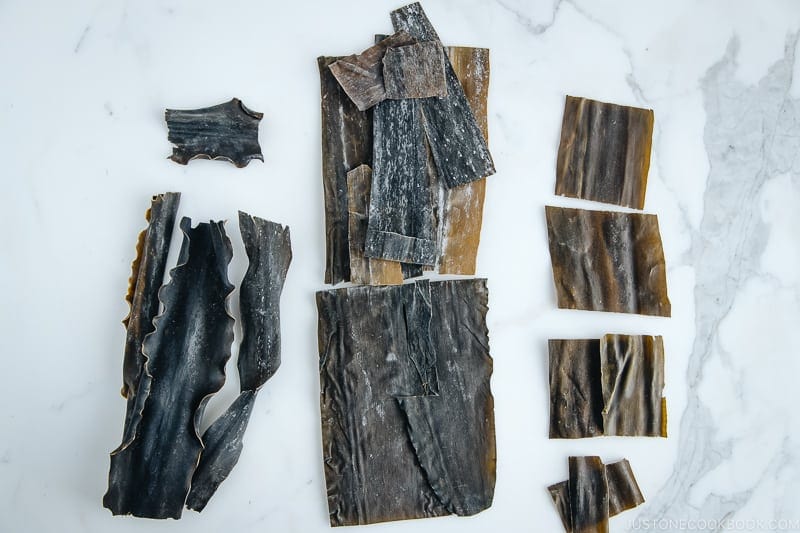
If you follow a vegetarian/vegan diet or simply want to embrace a more plant-based diet, kombu is an outstanding ingredient to incorporate into your cooking. Besides being a great flavor enhancer and tenderizer, kombu is a powerful, health-promoting food that can make up for certain nutrients that are absent in the diets.
In my pantry kombu page, I discuss different types of kombu and which kombu is good for specific types of dishes. Please go over the post if you want to know more about how to use kombu for Japanese cooking. You can find it at Japanese and Asian grocery stores.
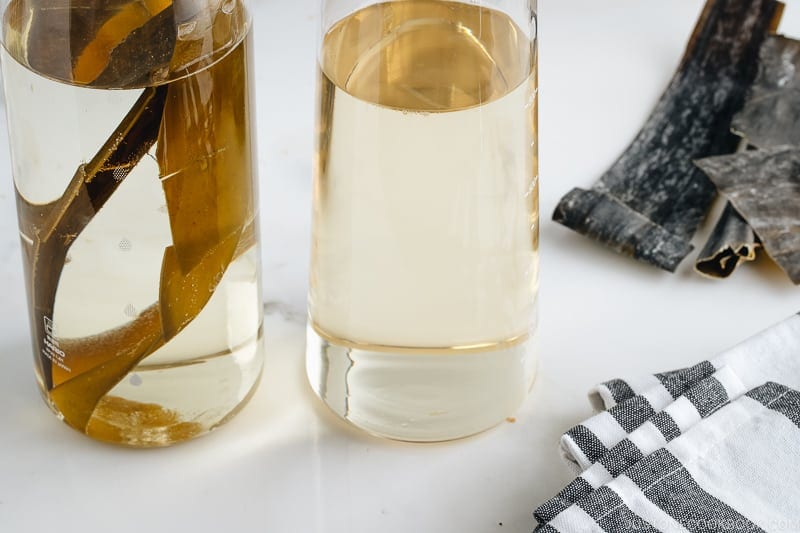
Ingredients You’ll Need
It takes just two ingredients to make this essential soup stock:
- kombu – dried kelp seaweed
- water
How to Make Kombu Dashi: Two Methods
Method 1: Cold Brew
The cold brew method known as mizudashi (水出し) is pretty hands-off. All you need is to put water and 1–2 kombu strips in a large bottle and let it steep for 2–3 hours or more.
Method 2: Hot Brew
If you need dashi right away, the hot brew or nidashi (煮出し) method is the one to use:
Just place the kombu and water in a medium pot and gently bring out the flavor. Turn off the heat just before it comes to a boil and remove the kelp.
Tips on Cooking with Kombu
- Don’t wash or wipe off the white powdery substance. The white powder compound known as mannitol is the key contributor to umami. The surface of kombu is pretty clean these days, so you may not need to wipe it.
- Make a couple of slits on the kombu to help release more flavor.
- Repurpose the leftover kombu into Kombu Tsukudani (Simmered Kombu) or Homemade Furikake (rice seasoning).
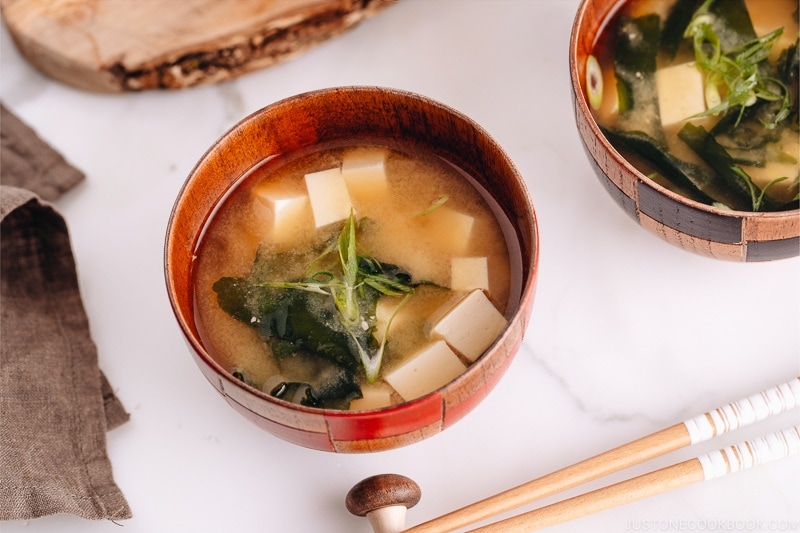
Recipes Using Kombu Dashi
Try these recipes that use kombu dashi stock for a flavorful broth:
- Shabu Shabu (hot pot with vegetables, tofu, meat, mushrooms, and udon noodles)
- Mizutaki (Chicken Hot Pot)
- Mizore Nabe (Hot Pot with Grated Daikon)
- Vegan Miso Soup
- Japanese Vegetable Soup (Kenchinjiru)
- Clear Clam Soup (Ushiojiru)
- Tomato and Tofu Miso Soup
If you can’t access kombu, another delicious option for vegetarian/vegan dashi is Shiitake Dashi.
The Ultimate Dashi Guide
Dashi plays an important role as a flavor enhancer in Japanese cooking, so you don’t need to season the food with too much salt, fat, and sugar. Rich in minerals and other vitamins, dashi is considered a healthy ingredient in our daily diet.
There are six different types of dashi you can use in Japanese cooking, including vegetarian and vegan dashi (*).
- Awase Dashi – a stock made from a combination of kombu + katsuobushi (dried bonito flakes)
- Kombu Dashi * – a stock made from kombu
- Katsuo Dashi – a stock made from dried bonito flakes
- Iriko Dashi – a stock made from dried anchovies/sardines
- Shiitake Dashi * – a stock made from dried shiitake mushrooms
- Vegan Dashi * – a stock made from dried shiitake mushrooms and kombu
If you are new to different types of dashi, check out my Ultimate Dashi Guide.
Wish to learn more about Japanese cooking? Sign up for our free newsletter to receive cooking tips & recipe updates! And stay in touch with me on Facebook, Pinterest, YouTube, and Instagram.

Kombu Dashi (Vegan Dashi)
Video
Ingredients
- 1 piece kombu (dried kelp) (10 g; 4 x 4 inches, 10 x 10 cm per piece)
- 4 cups water
Instructions
- Gather all the ingredients. Most Japanese recipes say to gently clean the kombu with a damp cloth. However, these days, kombu is pretty clean so just make sure it doesn‘t have any mold spots and it‘s ready to use. Do not wash or wipe off the white powdery substance as it has lots of umami.
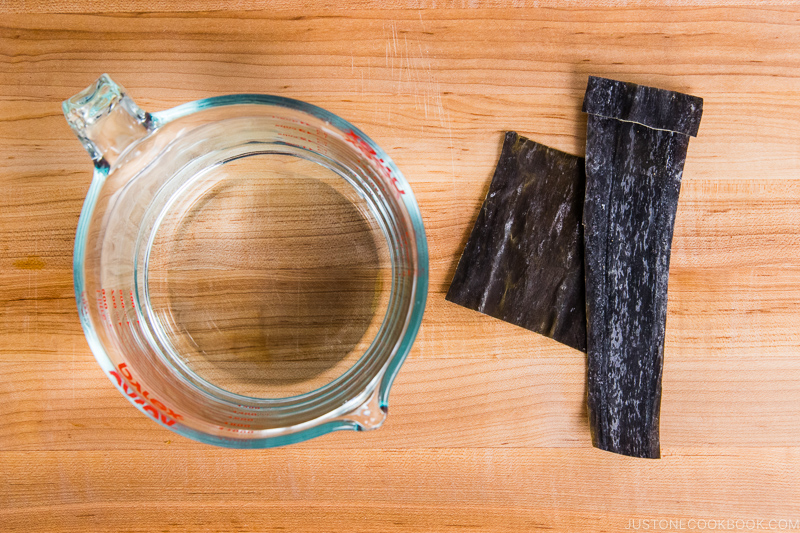
- Make a couple of slits on 1 piece kombu (dried kelp) to release more flavor.
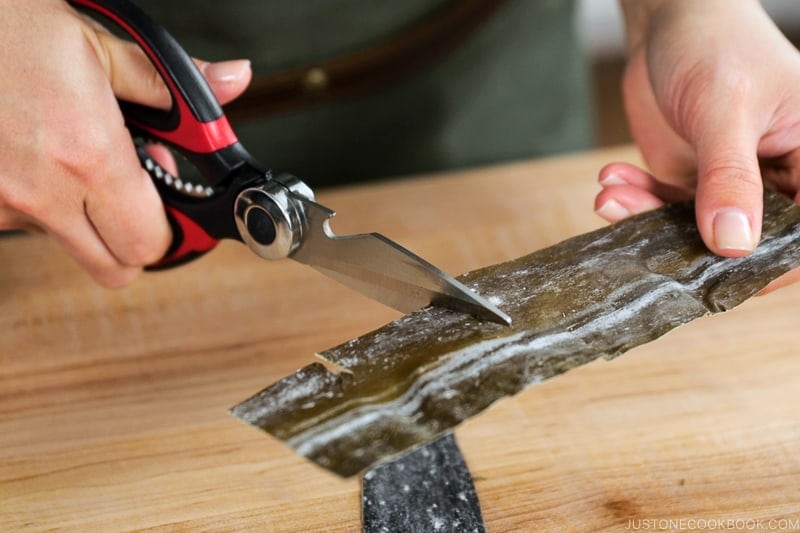
Method 1: Cold Brew Kombu Dashi (Mizudashi)
- Put 4 cups water and the kombu in a large bottle.
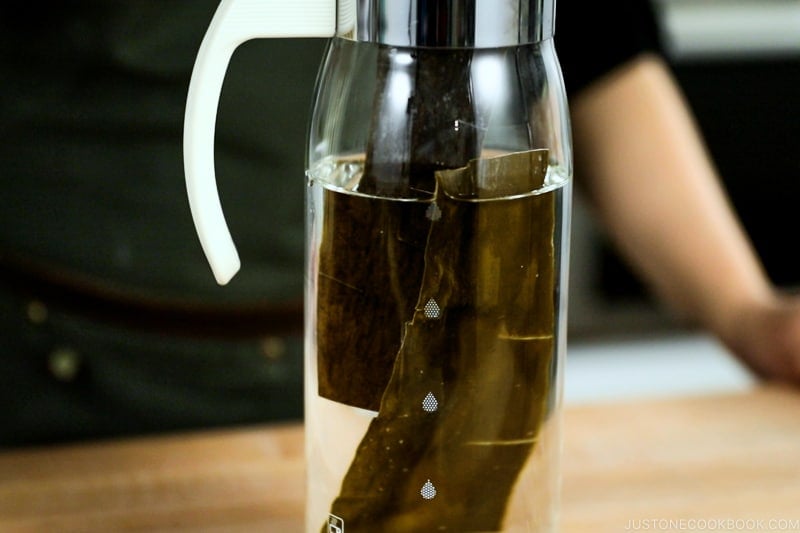
- Put the cap on and let it steep on the counter for 2–3 hours in the summertime and 4–5 hours in the wintertime. You can also cold brew the Kombu Dashi overnight in the refrigerator.
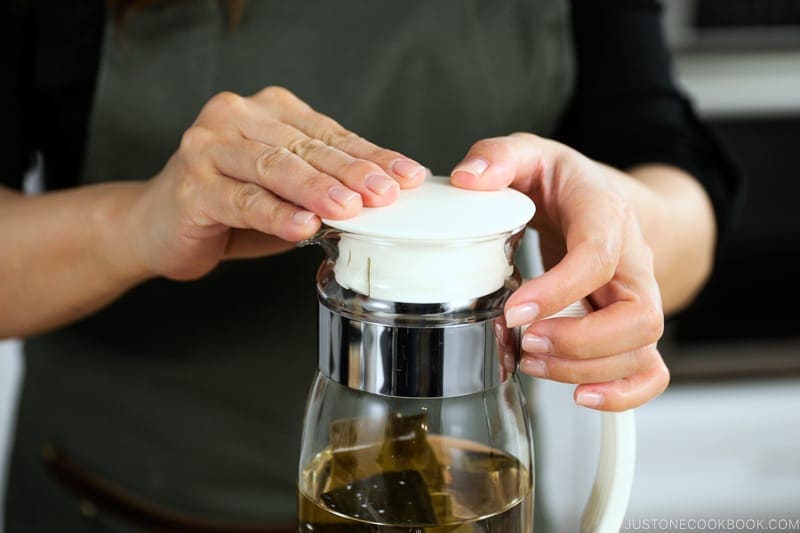
- Remove the kombu from the bottle and reserve the spent kombu (see below). The Kombu Dashi is now ready to use. If you are not using the dashi right away, save it in a bottle and keep in the refrigerator for 4–5 days or in the freezer for 2 weeks. I recommend using it sooner for the best flavor.
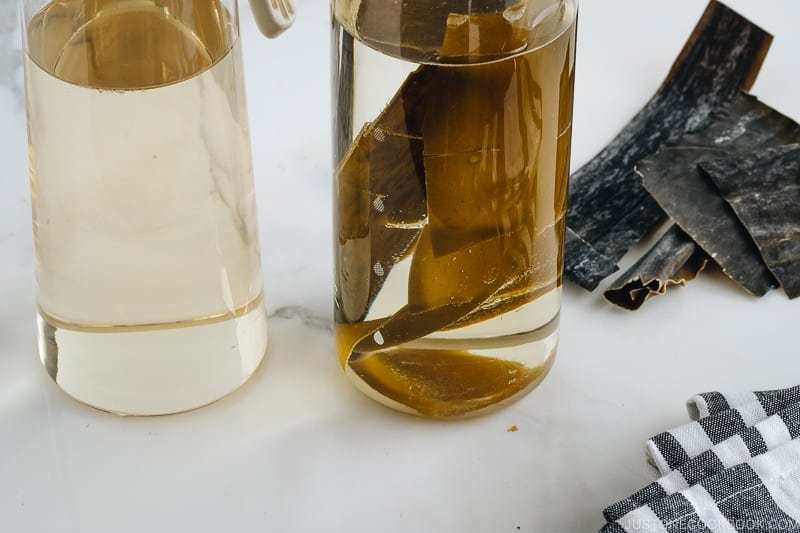
Method 2: Kombu Dashi on the Stovetop (Nidashi)
- Put the kombu and water in a medium pot. If you have time, soak for 3 hours or up to a half day. The kombu’s flavor comes out naturally from soaking in water.
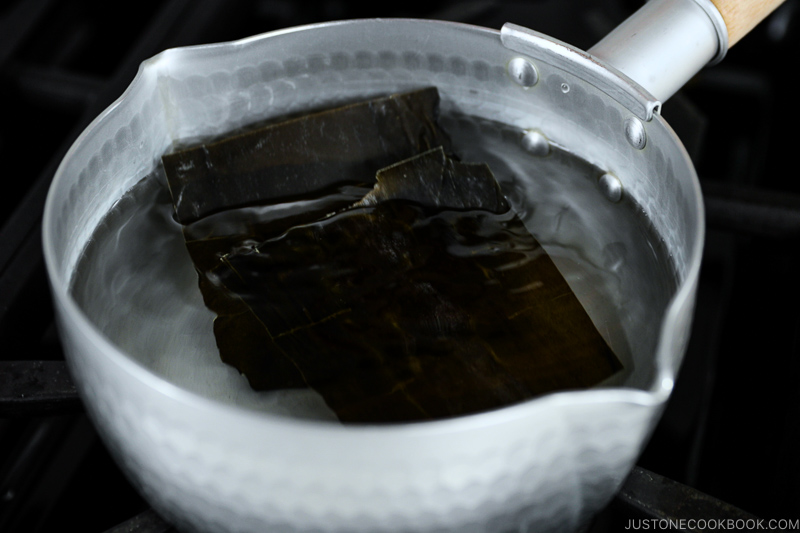
- Turn on the heat to medium low and slowly bring to a bare simmer, about 10 minutes.
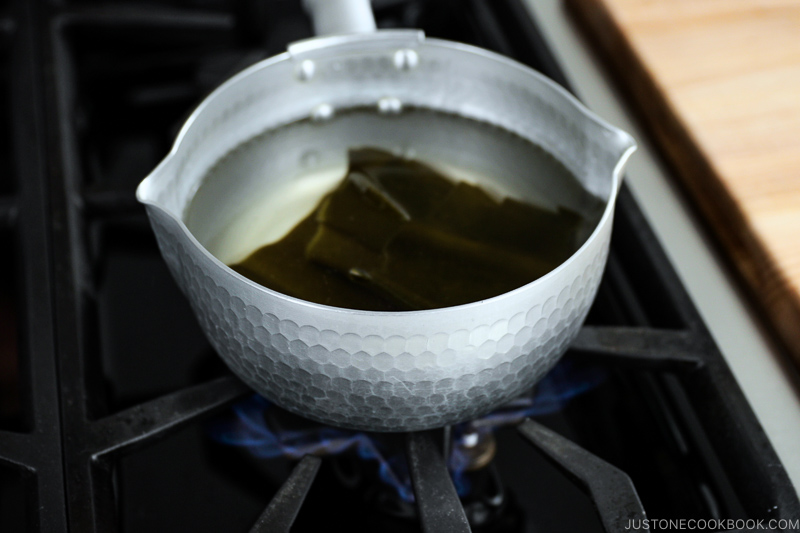
- Meanwhile, clean the dashi by skimming the foam from the surface with a fine-mesh skimmer.
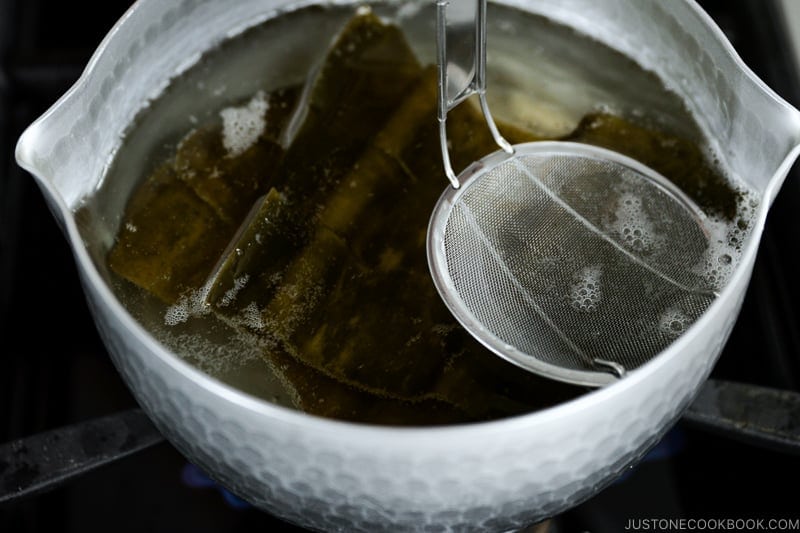
- Just before the dashi starts boiling, remove the kombu from the pot (see below for what to do with it). If you leave the kombu in the pot, the dashi will become slimy and bitter.
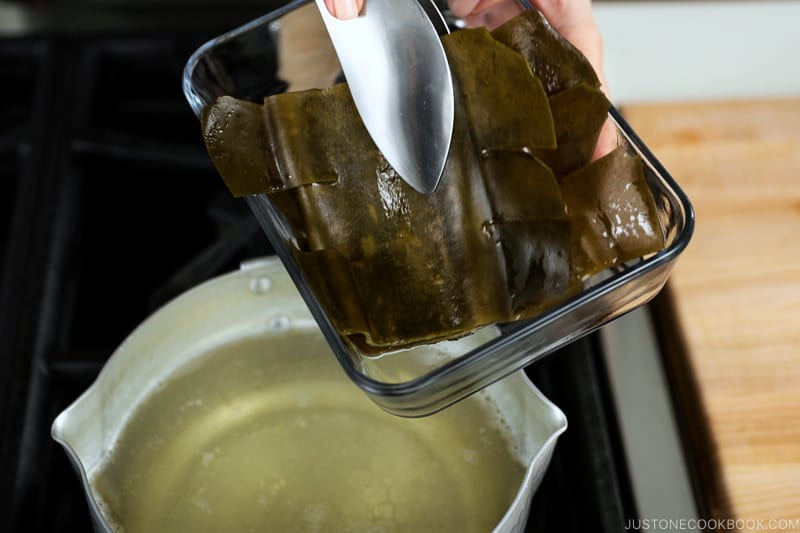
- Now the Kombu Dashi is ready to use.

To Store
- If you are not using the dashi right away, keep it in a bottle or airtight container and store in the refrigerator for 4–5 days or in the freezer for 2 weeks. I recommend using it sooner for the best flavor.
What to do with the spent kombu?
- Save the spent kombu in an airtight container and store it in the refrigerator for a week or in the freezer for up to a month.
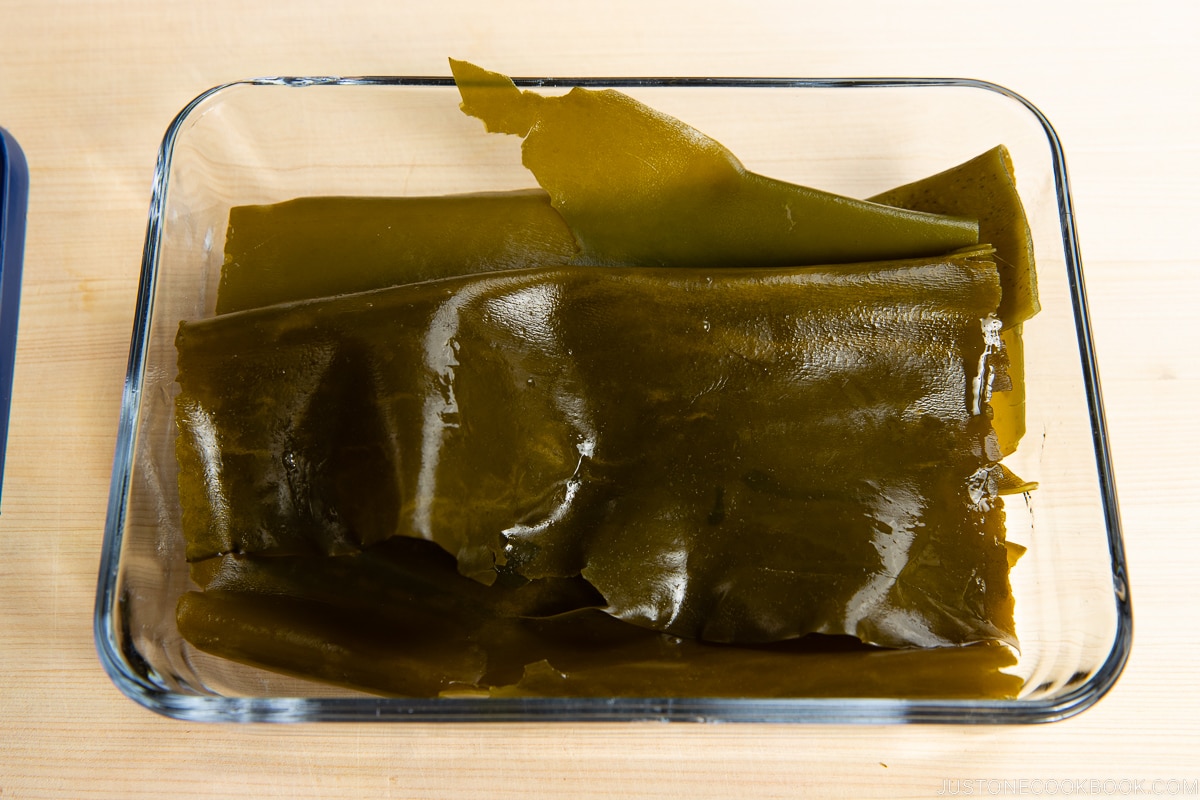
- With the spent kombu, you can make Simmered Kombu (Kombu Tsukudani).
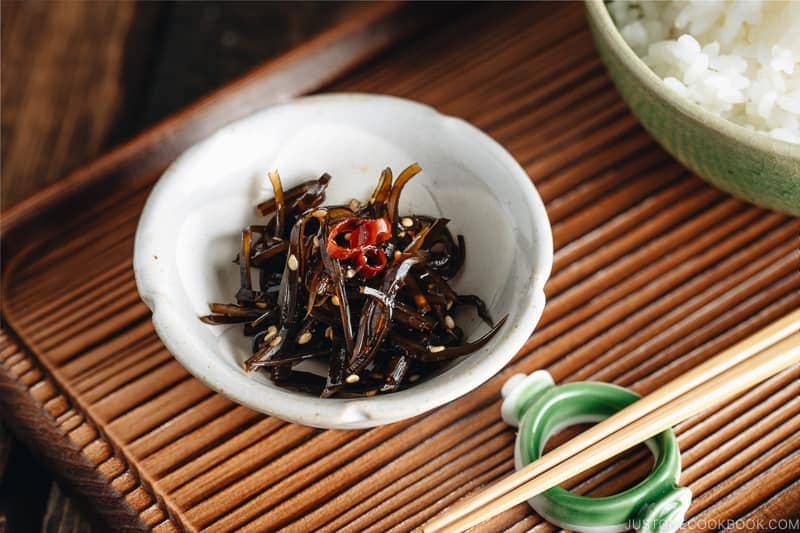
- You can also make Homemade Furikake (Rice Seasoning).
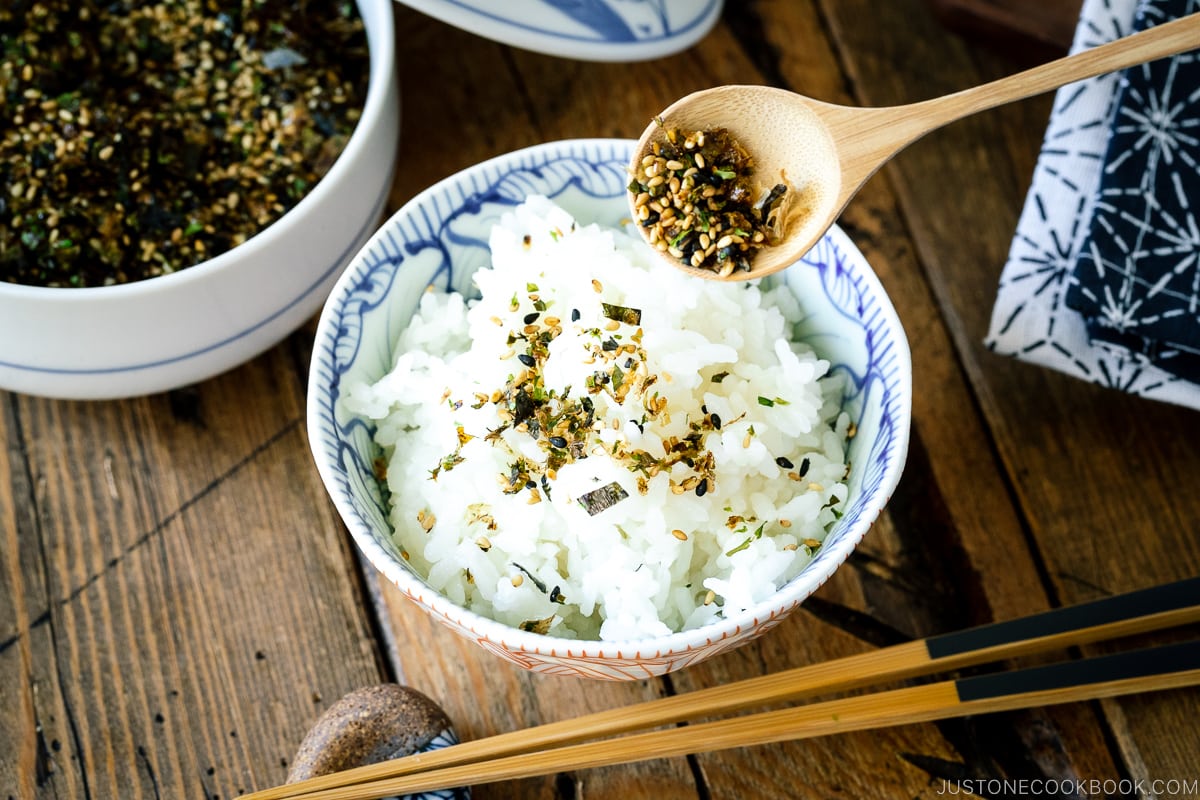
Nutrition
Editor’s Note: This post was originally published in February 2013. The images have been updated in April 2019.
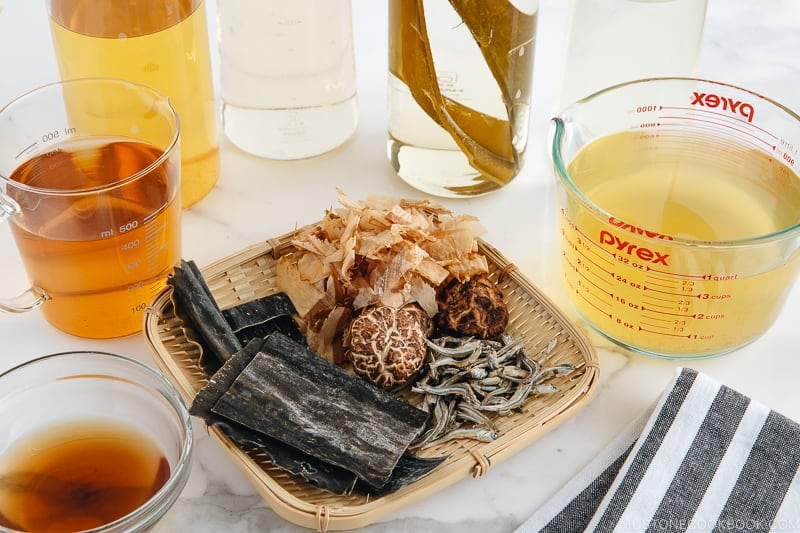
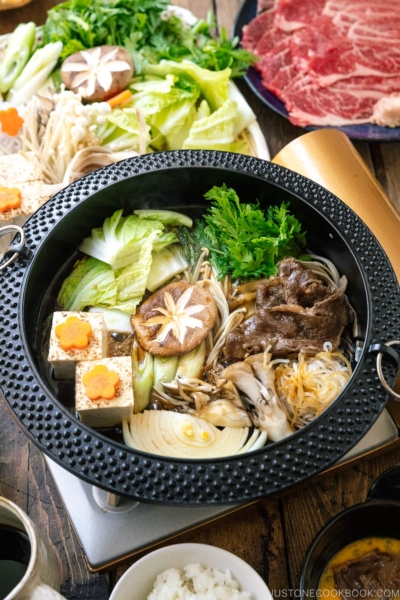
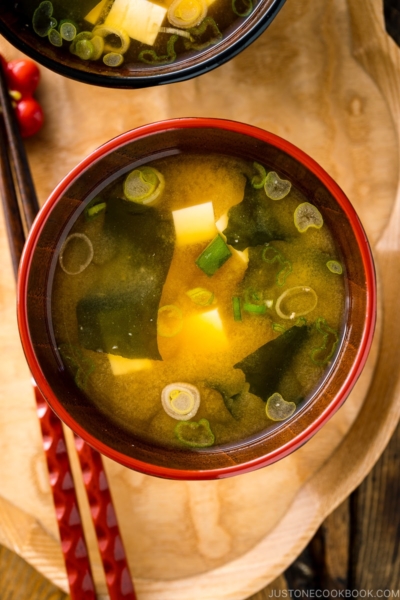
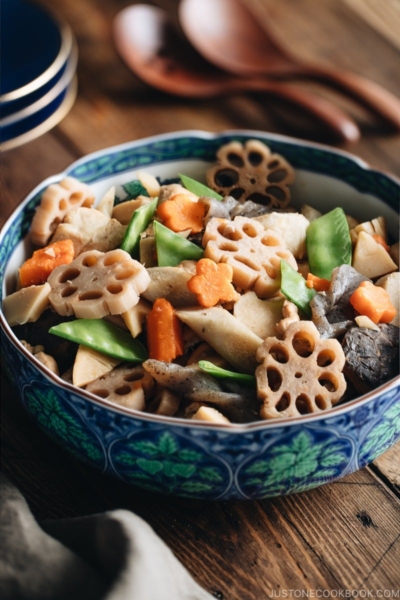
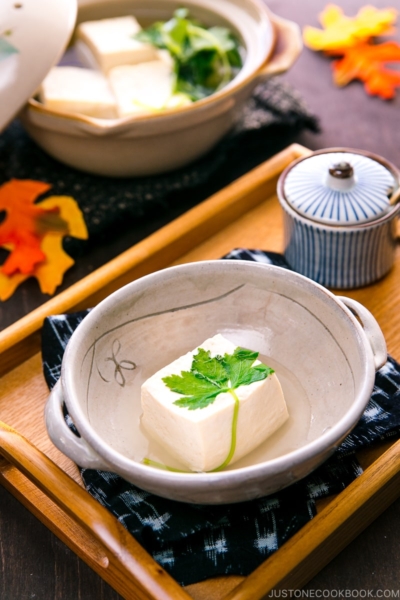




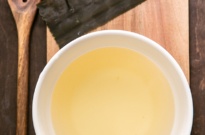
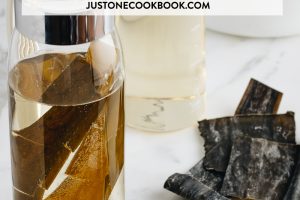
Hello,
If making the cold-brew dash where you simply soak the the kombu overnight in water, is the amount of water the same as if you did not pre-soak. And do you use this same water when heating up for the soup base?
Hi, Tom! Thank you for trying Nami’s recipe.
Yes. The water amount will be the same as specified on the recipe card. After presoaking the Kombu, the water is ready for use as a soup base (Dashi).
We hope this helped!
Is it okay if the kelp comes out of the water slimy? I had it soaking for 5 hrs
Hello, Gigi. Thank you for trying Nami’s recipe.
It depends on the type of Kombu and water; it might get slimy quickly.
If the Dashi is too slimy to use in the soup, or if you dislike the texture, you may wish to avoid it. It is up to you. You may also use it to make Nimono and other dishes. We hope this helps!
Hi! What bottles/pitchers are you using in these pictures? They look really cool and stylish. Thanks!
Hi Ron, The bottles are from Hario. We love their quality!🙂
https://www.amazon.com/dp/B001HBUTQG?linkCode=ssc&tag=onamzjusoneco-20&creativeASIN=B001HBUTQG&asc_item-id=amzn1.ideas.JD39FUPH6SRN&ref_=aip_sf_list_spv_ons_d_asin
Hi there, I’d like to know which of the knives that is listed on Amazon is good to use?
thank you!
Hello, Cecilia. Thank you so much for taking the time to read Nami’s post!
All of the knives listed are Nami’s favorites and are excellent. On this page, you may learn more about each knife to help you select the best fit for your needs. We hope you found this helpful!
Can I steep Kombu for too long? I’ve had a Kombu shiitake mixture steeping for over a week and don’t know if I can still use it
Hi Pat, Thank you so much for trying Nami’s recipe.
Dashi usually becomes slimy after steeping Kombu for an extended period of time. We recommend removing the Kombu after it has steeped overnight in the refrigerator. We hope this helps!